|

Picture 1
This is a panoramic view of the
church. The
ceiling is only 18 feet high.
The width is
51 feet and length 62 feet.
The church seat 300 people.
Style of Worship - Traditional
- moving to
a blended worship.
The center of the front wall
and the back
wall are parallel. The two side
walls are
parallel.
Behind the choir - it is recommended
vertical
10 inch PVC pipe, cut in half
and placed
on 16 inch centers from floor
to ceiling.
Curved side out(convex side out).
Paint and
dress as needed. They will look
like pillars.
The same can be done on the side
walls with
3 half round tubes between the
windows -
window and door on both sides.
Use more of the same tubes on
the side and
behind the soundman. This will
give him a
better approximation of the whole
room without
moving the sound booth. Yes,
it would be
better to move the booth, but,
this is a
workable compromise. To move
the booth forward
would either meaning cutting
the concrete
floor or having a wire pole from
the ceiling
to the floor.
Only 1 ceiling fan is needed
in the room.
It should be near the back and
left on during
the week and turned off during
worship.
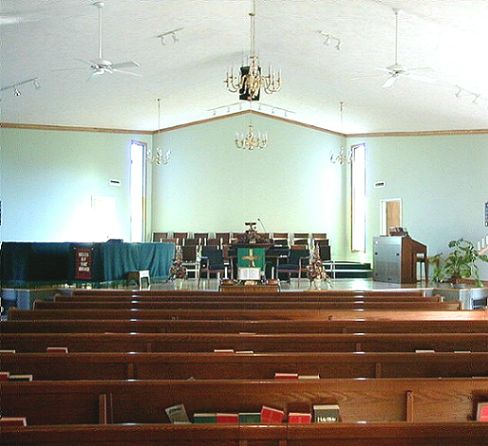
Picture 2
This is a view that over twenty
seats in
the sanctuary have. The lights
and fans are
blocking the speaker or as some
would say
it, "sitting in the shadow
of the sound."
The stage floor is not carpeted.
This is
good. They built too high on
the risers.
It should be 2 rows of seating
for each step
up. Otherwise the wood floor
has little value.
Fortunately, the risers are portable.
Since the picture was taken,
they did try
the choir loft with only 1 riser.
The choir
director is much happier.
They were wanting to hang mics.
I suggested
they try an experiment. The put
a mic on
a stand at 7 feet and a mic on
a stand at
4 feet. The lower mic position
worked much
better at about 8 feet from the
front of
the choir on the platform and
3 feet off
the floor. Placing the mic there
took advantage
of the wood floor.
The lights and the ceiling fans
are too low.
While this is a poor way to light
up a sanctuary,
the speaker system was put up
after the lights
were installed. Since these lights
are on
chain, they can be easily raised
or change.
They are recommended to be changed.
The Organ is on the right and
the speakers
are built in. It is recommended
to get external
speakers. Placement could be
a discussion
at another time. The piano is
behind the
pulpit in the center. The two
tables on the
right are for a church bell group.
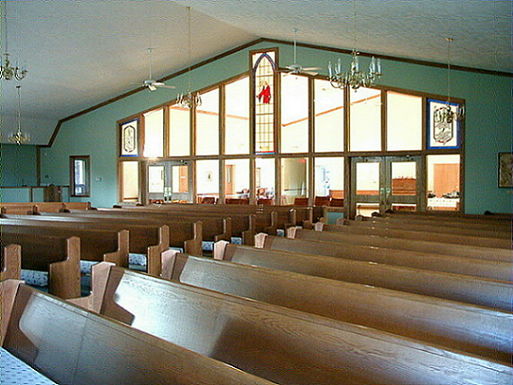
Picture 3
This is a view of the back wall.
In the left
corner is where the soundman
sits.
The Glass wall does present an
echo problem.
The frames are large enough that
the glass
can be angled within the frames.
The bottom
row shall be tilted forward at
the top and
push all the way back at the
bottom. This
also helps with the acoustics
of the fellowship
hall behind the glass. The center
stain glass
window can remain as it is.
The pew seats are padded. The
floor is carpeted.
Adding padded backs will not
change much
more. If you really needed more
dampening,
the cost of padding the back
could be better
spent with treating more important
surfaces
like the narrow space above the
windows with
a thick fiber material.
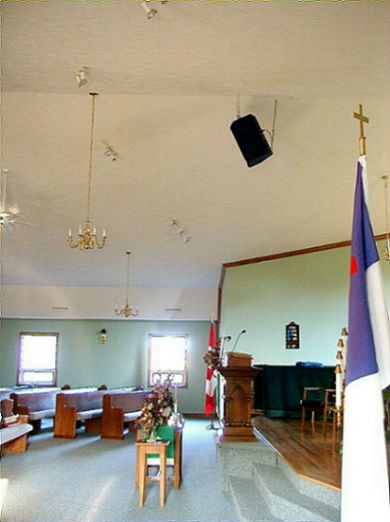
Picture 4
This is a profile picture of
the the speaker
system, the pulpit and the seating.
Above the windows are the ducts
for heating
and air.
The speaker system is not in
the sweetspot
of the room. It has to move a
18 inches forward.
The pew arrangement had been
changed. They
added another pew in the middle.
The pulpit
will no longer be on the riser
and the stairs
will be changed to a flat front
face for
8 feet - 4 feet on either side
of the pulit.
The speaker could have been tilted
down more
as the horn is on top.
The speaker will be changed from
the JBL
to 1 EAW speaker MK5164 and 2
Tannoy CPA
5 speaker. Since the seating
is divided into
3 sections, the speakers will
have the least
amount of comb filtering in this
setup in
the seating areas. However, if
the room had
a center isles, this could have
been a simpler
2 speaker system with 2 EAW MK2194
speakers
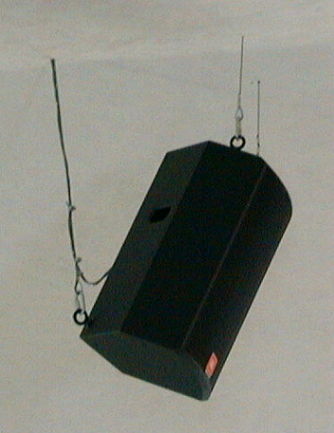
Picture 5
This is now knit picking, but
important.
As a safety issue and being legal,
anything
that weighs more that 15 pound
or higher
that 18 feet has to have more
the one method
securing it in a suspended manner.
If the
product is not attached as real
property
:i.e. suspended in an all steel
bracket,
the suspended object must have
a backup.
Therefore, in this example, there
should
have been a chain backup to the
cable. If
the speaker was suspended with
chain, it
would be backed up with cable.
- not in those
exact words, but that is what
the laws says
in Canada and the USA. In all
systems that
I do, the speaker is supported
by the sides
with - if the speaker is not
built for suspended
- a threaded rod that goes through
the speaker.
An all steel "U" bracket
is used.
The steel is 1 1/2 box tubing
and flat bar
3/16 wall or thicker. Overhead
the bracket
is bolted to a truss or a support
plate in
the attic. Doing this provides
the best transfer
of bass energy into the room
with the least
amount of speakers. By shaking
the roof,
it transfers just enough energy
into the
seats of the pews giving the
sensation of
raw bass energy without excessive
loudness.
This is part of the reason we
have been able
to install smaller cluster in
some churches
and why most of our clients don't
ask for
subs. Others may not agree with
this technique,
but it does work well in churches
under 2000
seating.
In general practice, in most
systems where
the stage is deep enough, the
best place
for a choir monitor is behind
the cluster.
In this case, A Tannoy CPA5 would
do the
job. A larger speaker would create
a bass
problem and bass smearing.
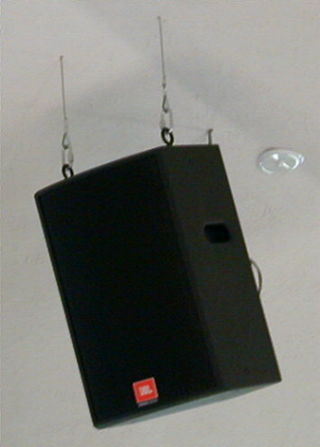
Picture 6
It is one thing to just hang
a speaker, it
is another thing to know how
to get every
ounce of performance from it.
Judging from
the handles positions and the
JBL logo plate,
it would be safe to assume the
horn of the
speaker is on top. It should
have been on
the bottom of the speaker. There
are two
reason for this. The first of
clearance of
lights and other objects. The
second is using
the 1/2 space principle for getting
more
bass out of the speaker that
is there. Just
as you place the woofer on the
floor when
you are using speakers in portable
setup,
do the same with the roof. When
suspended
speakers, think of the ceiling
as a floor
and when you can, take advantage
of the roof.
Regardless, it is often best
to put the horns
under the woofer in a church
install.
Oh and only more thing, it is
a good thing
the speaker wasn't painted. Otherwise,
the
church would not have been able
to return
the speaker to get their permanent
speaker
system which is custom painted
before it
is installed. I have never installed
an undress
speaker system.
Comments. As I mentioned before, this system has
to be done all over again. The
platform is
big enough that it should have
be wired for
16 mics and not the 4 mic lines
they have
now. Remember, the sound system
should be
designed for the room, not just
for how it
is used. Just as you don't put
a 4 cylinder
engine into a stretched Cadillac
Limousine
that will only carry two people
in it. You
put the proper sized engineer
that the car
required to have to perform safely.
Likewise,
the stage should have been better
wired and
prepared. 4 new speaker line
will have to
be added. The contractor used
16 gauge wire
and the speaker run is long enough
that it
should have been 14 gauge. Since
going to
3 speakers for the cluster and
one for a
choir monitor, all of the speaker
lines are
being replaced and the 16 gauge
wire will
be reused for a 70 volt system.
Another two
more speaker lines will be installed
for
floor monitors. These are things
that all
church sound systems should plan
for, even
if you don't use them right away.
On the
other hand, if you already know
that you
have an active music program,
then you can
add more speaker and mic lines
as needed.
I was just outlining the minimum
needed.
This is by no means a perfect
system. Some
mentioned delayed speakers and
other options.
Depending on the style of service,
those
items are just that, options,
to be used
based on the worship and budget.
The outline
given meets the minimum of the
HIS System
Standard. Yes, one could choose
better speakers,
better mixer, better acoustical
treatment
and so on. But in reality, we
are all restricted
by budgets and needs. I would
hope that by
using a standard such as the
HIS System,
churches can be better serviced
by professional
and for themselves when planning
church sound.
In the case of this church, it
is only 3
months old and they already are
looking at
their 2nd sound system. If they
knew of the
HIS System standard, I don't
think they would
be in this position today.
Thank you everyone for your comments
and
ideas.
I Hope you have enjoy this exercise.
If you
want me to do more critiques
like this, pleas
email me direct. If you have
photos and a
place to store them on a web
site, please
let us know and we well help
you. If not
me, others can help..
|

